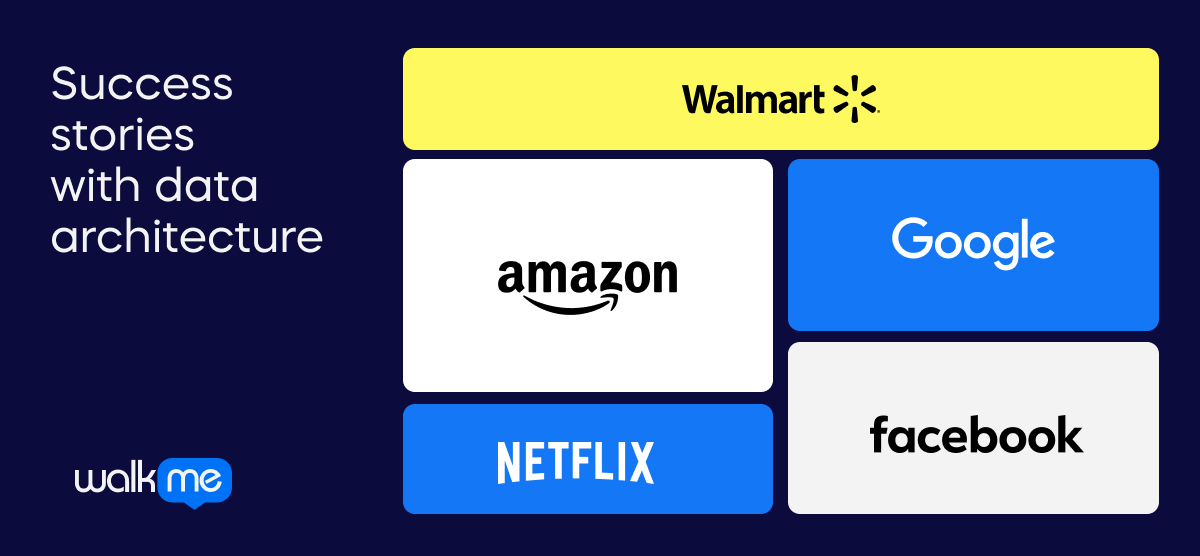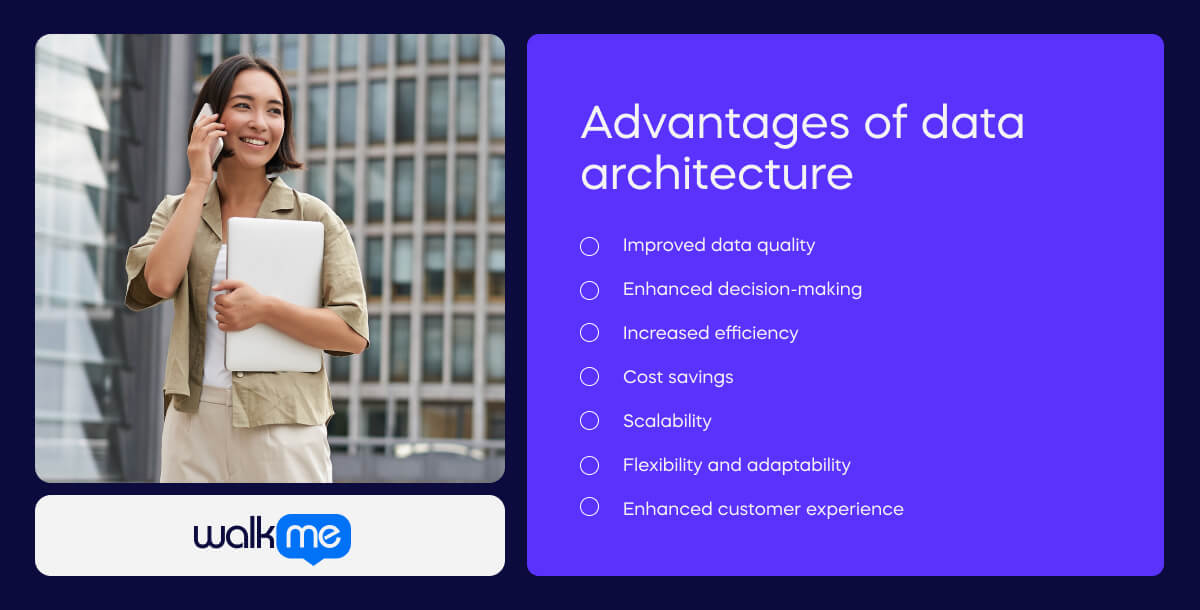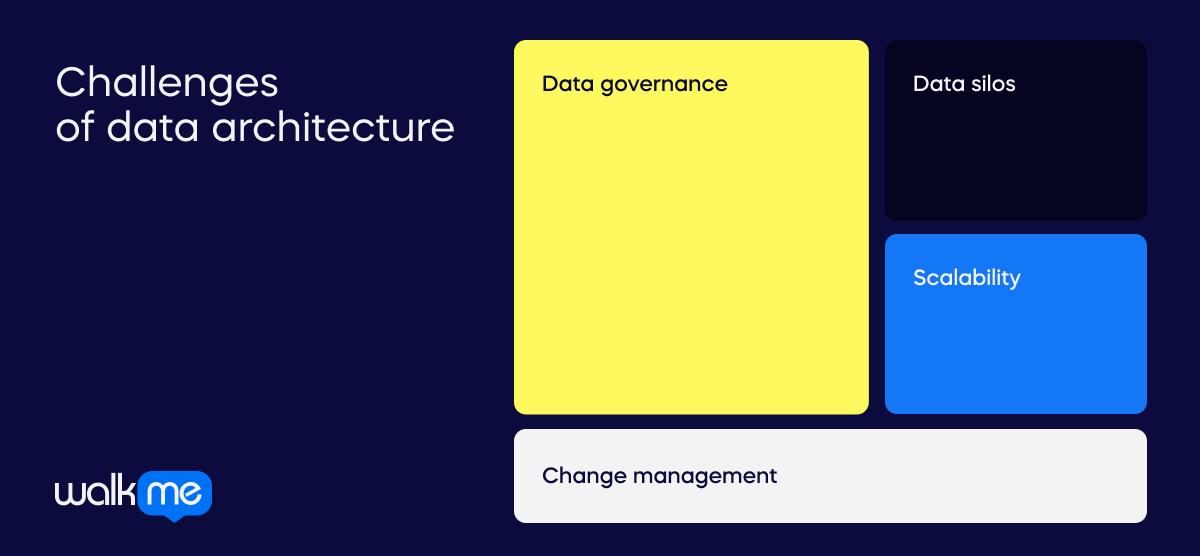What is data architecture?

Table of contents
Data architecture refers to the design and structure of an organization’s data systems.
It defines how data is collected, stored, processed, and accessed within an information technology environment.
A well-defined data architecture helps ensure data integrity, security, and accessibility, supporting efficient and effective use of information for decision-making and business processes.
Here’s a concise overview of the primary facets or functionalities of data architecture:
Data modeling
Defines the structure and relationships of data entities, ensuring a clear representation of how data is organized and accessed.
Data storage
Determines the storage methods and technologies for efficiently and securely storing data, considering factors like databases, data warehouses, and data lakes.
Data integration
Establishes processes for combining and consolidating data from various sources, ensuring consistency and accuracy for comprehensive insights.
Data security
Implementing measures to safeguard sensitive information, including encryption, access controls, and compliance with regulatory requirements.
Data governance
Defines policies and procedures for managing data assets, ensuring data quality, integrity, and adherence to standards across the organization.
Data processing
Designs workflows and systems for processing and transforming raw data into meaningful information, supporting analytics, reporting, and decision-making.
Metadata management
Maintains comprehensive metadata to provide context and understanding of data elements, facilitating efficient data discovery and utilization.
Scalability and performance
Plans for scalability to handle growing data volumes and ensure optimal performance of data processing and retrieval operations.
Data lifecycle management
Establishes procedures for the full data lifecycle, from creation and storage to archiving or deletion, to optimize resource utilization and compliance.
Data accessibility
Ensures easy and secure access to data for authorized users, considering factors like APIs, data catalogs, and user interfaces.
These functionalities collectively form the backbone of a well-structured data architecture, providing a framework for organizations to leverage their data effectively and drive business success.
Why is data architecture important?
Data architecture is critical for any digital solution, especially for a complex and dynamic platform like WalkMe.
The company uses data to understand user interactions across its entire tech stack and to create personalized and engaging experiences for end-users.
WalkMe also empowers organizations to make data-driven decisions and optimize their business processes.
Some of the key aspects of data architecture within the WalkMe framework are:
WalkMe Data
WalkMe Data is information that can be stored in the end user’s browser, such as user actions, preferences, or progress.
This data can segment users, create rules, and trigger content based on user behavior.
For example, WalkMe Data can record a user who has completed a certain action and then display additional guidance or feedback.
WalkMe Data can also measure the steps a user has completed in a process and resume guidance where they left off.
WalkMe Editor
WalkMe Editor is a no-code tool that allows organizations to build and manage their WalkMe content and logic.
The Editor uses UI Intelligence, a machine learning algorithm, to identify and interact with on-screen elements.
The Editor also enables users to define data sources, such as variables, cookies, or on-screen elements, and use them in rules or actions.
WalkMe Insights
WalkMe Insights is a powerful analytics tool that gives organizations visibility into their digital usage and performance.
The system collects and analyzes data from various sources, such as user actions, feedback, errors, or goals.
It also allows users to create custom reports and dashboards and integrate them with other analytics platforms, such as Google Analytics or Adobe Analytics.
Data architecture is essential for WalkMe to deliver its value proposition of enabling digital adoption and transformation.
Designing and organizing data coherently and efficiently enables WalkMe to provide organizations with the following benefits:
Enhanced user experience
WalkMe can create personalized and engaging end-user experiences based on their behavior, preferences, or needs.
The software can also provide users real-time guidance, feedback, and automation to help them complete tasks and achieve goals.
Increased efficiency
WalkMe can help organizations optimize business processes by reducing errors, training time, and support costs.
They can also help organizations streamline workflows by integrating and automating actions across multiple applications.
Data-driven decision making
WalkMe can help organizations leverage data to make informed and strategic decisions by providing insights into digital usage and performance.
The platform can also help organizations identify gaps, opportunities, and best practices and act on them accordingly.
Use cases for data architecture
Let’s explore scenarios across various contexts where data architecture is actively utilized:
Healthcare: Electronic Health Records (EHR) system
Data modeling: Designing a structured database to store patient information, medical histories, and treatment plans.
Data integration: Integrating data from diagnostic machines, labs, and different healthcare providers for a comprehensive patient record.
Data security: Implementing strict access controls and encryption to safeguard sensitive patient information.
Data processing: Enabling real-time data processing for monitoring patient vital signs and automating alerts for critical conditions.
Data accessibility: Ensuring authorized healthcare professionals have secure and timely access to patient records.
Finance: Fraud detection system
Data modeling: Creating a model to represent transaction data, customer profiles, and historical fraud patterns.
Data integration: Aggregating data from various sources like credit card transactions, online banking, and external fraud databases.
Data security: Employing advanced security measures to protect financial transactions and customer data.
Data processing: Implementing machine learning algorithms to analyze transaction patterns and detect anomalies in real-time.
Data accessibility: Providing fraud analysts with tools to quickly investigate and respond to potentially fraudulent activities.
Retail: Inventory management system
Data modeling: Structuring databases to manage product catalogs, stock levels, and supplier information.
Data integration: Integrating data from point-of-sale systems, online orders, and supplier databases to maintain accurate inventory levels.
Data security: Protecting sensitive information like supplier contracts and customer purchase history.
Data processing: Utilizing data analytics to forecast demand, optimize stock levels, and automate reordering processes.
Data accessibility: Empowering retail staff with user-friendly interfaces for real-time inventory tracking and order processing.
Telecommunications: Network performance monitoring
Data modeling: Designing a database schema to store network configuration, traffic data, and performance metrics.
Data integration: Integrating data from network devices, logs, and user feedback for a comprehensive view of network health.
Data security: Implementing measures to secure customer communication data and network configurations.
Data processing: Employing real-time analytics to monitor network performance, identify bottlenecks, and predict potential issues.
Data accessibility: Providing network administrators with dashboards and alerts for proactive management and troubleshooting.
Success stories with data architecture

Here are some examples of organizations that have successfully implemented data architecture, showcasing the benefits they achieved:
Netflix: Personalized content recommendations
Netflix uses a robust data architecture to collect and analyze user viewing habits, preferences, and feedback.
The personalized recommendation engine, powered by its data architecture, has significantly improved user engagement and retention. Users are more likely to discover content tailored to their interests, enhancing the overall streaming experience.
Amazon: Supply chain optimization
Amazon’s extensive data architecture integrates data from various sources, including customer orders, inventory levels, and supplier information.
Leveraging its data architecture, Amazon optimizes its supply chain operations. This has improved inventory management, reduced fulfillment costs, and faster order delivery, contributing to customer satisfaction and operational efficiency.
Google: AdWords and AdSense
Google employs a sophisticated data architecture for its advertising platforms, AdWords and AdSense, to process and analyze massive amounts of user behavior and ad performance data.
The data-driven approach enables Google to deliver targeted ads, improving ad relevance for users and increasing click-through rates for advertisers. This has resulted in a highly profitable advertising ecosystem for both Google and its partners.
Walmart: Inventory management and demand forecasting
Walmart utilizes a comprehensive data architecture to integrate data from point-of-sale systems, online orders, and supplier databases.
The data-driven inventory management system, supported by their data architecture, has significantly reduced stockouts, minimized excess inventory, and improved overall supply chain efficiency. This results in cost savings and a better shopping experience for customers.
Facebook: Social network analysis and targeted advertising
Facebook’s data architecture is designed to handle and analyze vast amounts of user-generated content, interactions, and demographic information.
Facebook’s targeted advertising platform leverages this data architecture to deliver highly personalized ads, improving ad relevance and click-through rates. Advertisers benefit from more effective campaigns, while users see content that aligns with their interests.
Data architecture and WalkMe
Here are two examples of organizations that have benefited from WalkMe’s use of data architecture:
Nestlé
Nestlé worked with WalkMe on a major change management project: shifting from an older SAP HR system to SAP SuccessFactors. This system was business-critical and impacted thousands of people.
WalkMe and Nestlé created personalized and engaging experiences for end-users based on their behavior, preferences, or needs.
The DAP company also helped Nestlé measure and improve the adoption and usage of SuccessFactors by providing insights into user actions, feedback, errors, or goals.
Nestlé reported more than $30M in inferred financial productivity gains over a rolling 12-month period and a 250% increase in task completion rates for specific processes in business-critical apps.
IBM
IBM used WalkMe to accelerate the adoption and growth of its cloud and AI solutions, such as IBM Cloud Pak for Data, IBM Watson Assistant, and IBM Cognos Analytics.
WalkMe assisted IBM with providing real-time guidance, feedback, and automation to help users complete tasks and achieve goals.
They also ensured IBM could leverage data to make informed and strategic decisions by providing analytics on user behavior, engagement, and satisfaction.
Examples of data architecture
How businesses find success with data architecture
Let’s explore three organizations successfully leveraging data architecture for their digital adoption strategies:
Airbnb: Dynamic pricing and personalized experiences
Airbnb employs a sophisticated data architecture to collect and analyze vast amounts of data, including user behavior, property details, and market trends.
They also use it to implement dynamic pricing algorithms. This enables hosts to optimize pricing based on factors such as demand, local events, and seasonality.
Additionally, the platform leverages user data to offer personalized travel recommendations and experiences.
The dynamic pricing strategy has increased host revenue, while personalized recommendations enhance the user experience by providing tailored travel options.
Airbnb’s success showcases how data architecture can drive revenue and improve customer satisfaction simultaneously.
Tesla: Autonomous driving and over-the-air updates
Tesla’s vehicles are equipped with advanced sensors, cameras, and connectivity, generating massive amounts of data on driving behavior, road conditions, and vehicle performance.
Tesla leverages its data architecture for continuous improvement of its autonomous driving capabilities.
The collected data trains machine learning models, enabling over-the-air updates that enhance vehicle safety and performance. This strategy allows Tesla to iterate and deploy improvements rapidly.
Tesla’s use of data architecture for over-the-air updates results in a fleet of vehicles that continually improves over time.
This approach enhances vehicle safety, provides a better driving experience for customers, and showcases the potential of data architecture in the automotive industry.
Spotify: Personalized music recommendations and Discover Weekly
Spotify’s data architecture processes vast amounts of user data, including listening history, preferences, and social interactions.
Spotify utilizes data architecture to power its recommendation algorithms. The platform analyzes user behavior to generate personalized playlists, such as the popular “Discover Weekly,” which suggests new music based on individual tastes. This personalization enhances user engagement and satisfaction.
The personalized music recommendations have led to increased user retention and engagement. By leveraging data architecture for accurate and relevant content suggestions, Spotify creates a more enjoyable user experience, contributing to its success in the competitive music streaming industry.
Data architecture vs data governance
Data architecture and governance are critical components of managing and leveraging data effectively within an organization. They serve different purposes and focus on various aspects of data management. Let’s compare the two:
| Data architecture | Data governance | |
| Definition | Structure and design of data systems and environments | Processes, policies, and controls for data management |
| Key components | Database design, data models, data storage solutions | Policies, standards, roles, and responsibilities |
| Objectives | Efficient data storage, access, and integration | Data quality, security, privacy, and compliance |
| Example activities | Database schema design, data flow definition | Data governance framework development, data quality standards |
| Focus | Technical infrastructure | Organizational policies and processes |
While data architecture focuses on designing the technical infrastructure and systems for managing data, data governance is concerned with establishing policy processes. It controls the necessary to ensure that data is collected effectively, securely, and in compliance with regulations and organizational requirements.
Both data architecture and data governance are essential for achieving data-driven decision-making and maximizing the value of an organization’s data assets.
Advantages of data architecture

As organizations increasingly rely on AI-driven insights for decision-making, ensuring the trustworthiness of data becomes paramount.
As Faisal Alam, EY Americas Consulting Emerging Technology Leader, aptly states, ‘In a world where data-driven insights are the oxygen of modern commerce, the difference between trustworthy and untrustworthy data is the difference between success and failure.’
This highlights the critical role of data architecture in enhancing data quality and establishing trust in the data used for AI applications.
Data architecture offers several advantages to organizations:
Improved data quality
By defining clear structures and processes for data collection, storage, and usage, data architecture helps maintain data consistency, accuracy, and integrity, leading to higher data quality.
Enhanced decision-making
Well-designed data architecture provides access to timely and relevant information, enabling better-informed decision-making at all levels of the organization. This leads to more strategic and effective business decisions.
Increased efficiency
Streamlined data flows and optimized storage systems improve data processing and retrieval times, reducing latency and increasing operational efficiency across various business functions.
Cost savings
Effective data architecture minimizes redundancy and ensures optimal resource utilization, leading to cost savings in terms of storage, processing, and maintenance of data infrastructure.
Scalability
Scalable data architecture allows organizations to accommodate growing data volumes and user needs without compromising performance or stability, ensuring that data systems can expand and evolve as the organization grows.
Flexibility and adaptability
A flexible data architecture can easily accommodate changes in data sources, technologies, and business requirements, enabling organizations to adapt quickly to new challenges and opportunities.
Enhanced customer experience
By leveraging data architecture to gain insights into customer behavior and preferences, organizations can deliver personalized and tailored customer experiences, leading to higher customer satisfaction and loyalty.
Challenges of data architecture

Organizations striving to adopt artificial intelligence (AI) face significant hurdles, as highlighted by a recent study conducted by the Manufacturing Leadership Council, 65% of manufacturing leaders identify data issues – ranging from access, format, integration, and privacy to governance – as the primary impediment to AI adoption within their companies.
This underscores the crucial role of robust data architecture in facilitating the effective deployment of AI across organizations.
While data architecture offers numerous benefits, it also comes with its own set of challenges:
Data silos
Organizations often struggle with data silos, where data is fragmented and isolated within different departments or systems. Overcoming these silos to achieve a unified view of data across the organization requires careful planning and coordination.
Data governance
Establishing and enforcing data governance policies, including data quality standards, privacy regulations, and access controls, can be challenging. Ensuring compliance with regulatory requirements and industry standards requires ongoing effort and investment.
Scalability
As data volumes continue to grow exponentially, scalability becomes a significant challenge. Ensuring data architecture can scale to accommodate increasing data volumes, user demands, and technological advancements requires careful planning and investment in infrastructure and resources.
Change management
Implementing changes to data architecture, such as upgrading systems, integrating new technologies, or implementing new data governance policies, can be met with resistance from stakeholders and require careful change management to ensure successful digital adoption and alignment with business objectives.
The future of data architecture
Data architecture is the foundational framework upon which organizations build their data-driven strategies and operations.
As outlined above, the advantages of data architecture are numerous, ranging from improved data quality and enhanced decision-making to increased efficiency and cost savings.
By leveraging data architecture effectively, organizations can overcome challenges such as data silos, scalability issues, and security concerns while also positioning themselves for future growth and innovation.
Furthermore, data architecture is crucial in reshaping operational dynamics by facilitating seamless data flows, fostering collaboration across departments, and enabling organizations to adapt quickly to changing market conditions.
As businesses continue to navigate the complexities of the digital landscape, investing in robust data architecture will be essential for achieving competitive advantage, driving business success, and unlocking the full potential of their data assets.
In looking to the future, the evolution of data architecture holds immense promise for organizations seeking to harness the power of data in increasingly sophisticated ways.
As technology advances, data architecture will likely become more agile and adaptable, enabling real-time processing of vast amounts of data from diverse sources such as IoT devices, social media platforms, and sensors.
The rise of cloud computing, artificial intelligence, and machine learning will further revolutionize data architecture, empowering organizations to extract actionable insights, automate decision-making processes, and drive innovation at unprecedented speeds.
Additionally, advancements in data privacy and security measures will continue to shape the landscape of data architecture, ensuring that organizations can leverage data responsibly while maintaining trust with customers and regulatory compliance.
As we venture into this future landscape, the role of data architecture will remain indispensable, serving as the cornerstone of digital transformation and organizational success in the data-driven era.